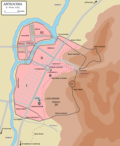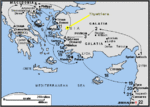Wikimedia Commons has media related to Prusias ad Hypium. Prusias ad Hypium (Ancient Greek: Προῦσα πρὸς τῷ Ὑππίῳ ποταμῷ) was a city in ancient Bithynia...
19 KB (2,269 words) - 09:44, 19 March 2024
Western Black Sea coast, prior to taking Bursa. In 1323, the city of Prusias ad Hypium was conquered from the Byzantine Empire by Osman Gazi (r. c. 1299–1323/4)...
4 KB (364 words) - 15:39, 7 January 2024
Prusias may refer to : People Two kings of ancient Bithynia Prusias I of Bithynia Prusias II of Bithynia Places and jurisdictions Prusias ad Hypium, city...
535 bytes (95 words) - 09:13, 24 June 2022
Prusias I a son called Prusias II, who succeeded him. The town of Prusa (now Bursa in Turkey), which he rebuilt, is named after Prusias. Prusias ad Hypium...
6 KB (547 words) - 23:24, 27 May 2024
Laodicea on the Lycus (redirect from Laodicea ad Lycum)
(Greek: Λαοδίκεια πρὸς τοῦ Λύκου Laodikeia pros tou Lykou; Latin: Laodicea ad Lycum, also transliterated as Laodiceia or Laodikeia) (modern Turkish: Laodikeia)...
21 KB (2,444 words) - 12:37, 7 August 2024
outside the Aurelian Wall, whose construction was begun in 274 AD and finished in 279 AD, the total inhabited area plus public spaces inside the walls...
60 KB (6,954 words) - 15:41, 24 September 2024
Cius (redirect from Prusias ad Mare)
Greek: Kίος or Κῖος Kios), later renamed Prusias on the Sea (/ˈpruːʒəs/; Latin: Prusias ad Mare) after king Prusias I of Bithynia, was an ancient Greek city...
8 KB (948 words) - 13:06, 14 February 2024
Phazemon Philocaleia Pida Pimolisa Polemonium Pompeiopolis Potami Prusias ad Hypium Pteria in Paphlagonia Salatiwara Samuha Sandaraca Sapinuwa Satala...
12 KB (1,227 words) - 19:54, 7 October 2024
remained primarily Greek-speaking until its conquest by the Ottoman Empire in AD 1453. The etymology of Byzantium is unknown. It has been suggested that the...
23 KB (2,557 words) - 02:10, 17 September 2024
rebuilt as Troy IX. A series of earthquakes devastated the city around 500 AD, though finds from the Late Byzantine era attest to continued habitation at...
86 KB (9,703 words) - 18:32, 19 September 2024
Antioch (redirect from Antiochia ad Orontem)
13 AD as part of a Mission to Augustus. At Antioch Germanicus died in 19 AD, and his body was burnt in the forum. An earthquake that shook Antioch in AD...
65 KB (8,202 words) - 12:33, 5 October 2024
Phazemon Philocaleia Pida Pimolisa Polemonium Pompeiopolis Potami Prusias ad Hypium Pteria in Paphlagonia Salatiwara Samuha Sandaraca Sapinuwa Satala...
27 KB (3,369 words) - 17:16, 24 August 2024
present-day remains date to the Roman era, the majority from after a 2nd-century AD earthquake. In practical terms, a distinction is often made between these...
32 KB (3,627 words) - 17:31, 6 October 2024
Phazemon Philocaleia Pida Pimolisa Polemonium Pompeiopolis Potami Prusias ad Hypium Pteria in Paphlagonia Salatiwara Samuha Sandaraca Sapinuwa Satala...
868 bytes (96 words) - 04:47, 28 March 2022
TR110. Elaea TR111. Mariandyn TR112. Claros TR113. Knidos TR114. Prusias ad Hypium TR115. Dardanus TR116. Pygela TR117. Temnos TR118. Gryneium TR119...
55 KB (4,785 words) - 15:43, 6 October 2024
the east. In 361 AD it was the location of the Chalcedon tribunal, where Julian the Apostate brought his enemies to trial. In 451 AD an ecumenical council...
15 KB (1,360 words) - 11:29, 8 August 2024
needed] Sardis began to decline in the 600s AD.(p1123) It remained part of the Byzantine Empire until 1078 AD, by the Seljuk Turks. It was reconquered in...
33 KB (3,444 words) - 11:45, 5 September 2024
Tarsus, Mersin (redirect from Antiochia ad Cydnum)
as Antiochia on the Cydnus (Greek: Αντιόχεια του Κύδνου, Latin: Antiochia ad Cydnum), to distinguish it from Syrian Antioch. The Romans knew it as Juliopolis...
36 KB (4,035 words) - 02:25, 4 September 2024
on the border between Lydia and Mysia. During the Roman era, (1st century AD), it was famous for its dyeing facilities and was a center of the purple cloth...
7 KB (740 words) - 15:27, 23 August 2024
Phazemon Philocaleia Pida Pimolisa Polemonium Pompeiopolis Potami Prusias ad Hypium Pteria in Paphlagonia Salatiwara Samuha Sandaraca Sapinuwa Satala...
33 KB (3,656 words) - 10:55, 5 October 2024
Pergamum (1st century AD), Christian martyr and saint. Aristocles (1st century AD), a Greek sophist Aelius Nicon (2nd century AD), Greek architect and...
79 KB (10,455 words) - 14:46, 15 September 2024
city was influenced by Latin culture, and it changed its name to Prusias ad Hypium. Later on Christianity affected the city and after the separation...
11 KB (810 words) - 08:35, 27 August 2024
grew to 60,000 inhabitants. This period would last well into the 3rd century AD. Side also established itself as a slave-trading centre in the Mediterranean...
17 KB (1,865 words) - 14:44, 4 October 2024
which occurred under Diocletian and his Caesar Galerius. On 23 February 303 AD, the pagan festival of the Terminalia, Diocletian ordered that the newly built...
17 KB (1,932 words) - 22:01, 2 September 2024
Panticapaeum Parium Patraeus Phanagoria Phasis Pityus Priapus Proconnesus Prusias (?) Sinope Scepsis Tanais Theodosia Tieion Tomis Tyras Tyritake Trapezunt...
37 KB (4,295 words) - 15:06, 19 June 2024
emerged in the region in the course of six centuries from 7th to 13th centuries AD". This is due to the cities "military, religious, and civil buildings". UNESCO...
69 KB (7,613 words) - 17:04, 6 October 2024
278 – c. 255 BC), as well as those of his successors, Prusias I (r. c. 228 – 182 BC), Prusias II (r. c. 182 – 149 BC) and Nicomedes II (r. c. 149 – 127...
19 KB (2,032 words) - 08:56, 1 June 2024
Magnesia ad Sipylum (Greek: Mαγνησία ἡ πρὸς Σιπύλῳ or Mαγνησία ἡ ἐπὶ Σιπύλου; modern Manisa, Turkey) was a city of Lydia, situated about 65 km northeast...
5 KB (541 words) - 23:55, 14 January 2024
long into the Middle Ages, known to have existed as late as the 11th century AD. Harran was captured by the Rashidun Caliphate in 640 and remained an important...
85 KB (10,029 words) - 11:16, 10 September 2024
site of the great Castle of St. Peter built by the Knights of Rhodes in 1404 AD. It was built on what was originally an island, which gradually expanded to...
25 KB (2,526 words) - 08:14, 14 March 2024


























